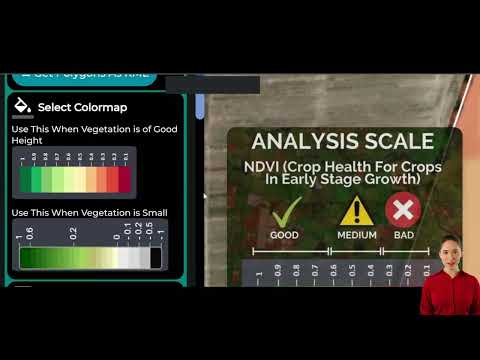Auburn’s Bold Move: Enhancing Watershed Management for Sustainable Agriculture and Water Quality
“Auburn’s new ordinance expands wetland buffer zones, potentially affecting up to 30% of local agricultural land.”
In a groundbreaking move that highlights the critical intersection of agriculture and environmental stewardship, the city of Auburn has taken significant steps to enhance watershed management and agricultural water quality. As representatives of Farmonaut, we’re excited to delve into these recent municipal ordinance changes and explore their far-reaching implications for sustainable farming practices and water resource protection.

The Auburn City Council’s recent 6-1 vote in favor of amending the Lake Auburn watershed ordinance marks a pivotal moment in the region’s approach to balancing agricultural productivity with environmental protection. These changes, stemming from the recommendations of an ad hoc committee, represent a comprehensive effort to address various environmental concerns, with a particular focus on the impact of agricultural activities on water quality.
Key Amendments to the Watershed Ordinance
The newly approved changes introduce several crucial provisions aimed at mitigating the potential negative effects of agricultural practices on water quality. Let’s break down the main components of these amendments:
- Expanded Buffer Zones: The ordinance calls for increased buffer zones around agricultural uses adjacent to wetlands, creating a vital barrier to protect these sensitive ecosystems.
- Fertilizer and Pesticide Restrictions: New regulations limit the use of fertilizers and pesticides in sensitive areas, addressing a significant source of water pollution.
- Clear-Cutting Regulations: The amendments impose restrictions on clear-cutting in watershed areas, helping to maintain natural vegetation that acts as a filter for runoff.
- Waste and Nutrient Management Plans: Existing farms within the watershed must establish comprehensive waste and nutrient management plans by June 30, 2027.
- Manure Management: New protocols prohibit the spreading of manure and mandate adequate storage to prevent groundwater contamination.
These changes reflect a growing recognition of the intricate relationship between agricultural practices and water quality. By implementing these measures, Auburn is taking a proactive stance in protecting its vital water resources while supporting sustainable agricultural practices.
The Importance of Watershed Management in Agriculture
Watershed management plays a crucial role in maintaining the delicate balance between agricultural productivity and environmental conservation. As we at Farmonaut understand, effective watershed management can lead to numerous benefits, including:
- Improved water quality for both agricultural and municipal use
- Enhanced soil health and reduced erosion
- Preservation of biodiversity in aquatic and terrestrial ecosystems
- Sustainable water supply for irrigation and other agricultural needs
- Reduced risk of flooding and drought impacts on farmland
By focusing on these aspects, Auburn’s new ordinance sets a precedent for other municipalities looking to balance agricultural needs with environmental protection.
Impact on Local Farming Communities
The new regulations undoubtedly present both challenges and opportunities for local farmers. While some may view the changes as restrictive, we believe they offer a chance to embrace more sustainable farming practices that can benefit both the environment and agricultural productivity in the long run.
Nutrient management plans, for instance, can help farmers optimize their use of fertilizers, potentially reducing costs while minimizing runoff. Similarly, improved waste management strategies can lead to better soil health and reduced risk of contamination, ultimately supporting healthier crops and livestock.
To assist farmers in adapting to these new requirements, it’s crucial for local agricultural extension services and organizations like Farmonaut to provide support and resources. Our satellite-based farm management solutions can play a vital role in helping farmers implement precision agriculture techniques that align with the new regulations.
Innovative Approaches to Reduce Agricultural Runoff
Auburn’s ordinance changes highlight the need for innovative approaches to reduce agricultural runoff and preserve water quality. Some cutting-edge techniques that align with these goals include:
- Precision Agriculture: Using satellite imagery and AI-driven insights to optimize irrigation and fertilizer application, reducing excess runoff.
- Cover Cropping: Planting cover crops during off-seasons to prevent soil erosion and absorb excess nutrients.
- Contour Farming: Plowing and planting across the slope of the land to reduce water runoff and soil erosion.
- Riparian Buffers: Establishing vegetated areas along waterways to filter out pollutants before they reach water bodies.
- Rotational Grazing: Managing livestock grazing patterns to prevent overgrazing and reduce soil compaction, which can lead to increased runoff.
These practices not only help in meeting the new regulatory requirements but also contribute to more sustainable and efficient farming operations.
“Implementing nutrient management plans could reduce agricultural runoff by up to 40% in the watershed area.”

The Role of Technology in Supporting Compliance
As we navigate these new regulatory waters, technology plays a crucial role in helping farmers comply with the updated ordinance while maintaining productivity. At Farmonaut, we’re proud to offer solutions that directly address many of the challenges posed by these new regulations:
- Satellite-Based Crop Health Monitoring: Our platform uses multispectral satellite imagery to provide real-time insights into crop health, soil moisture levels, and other critical metrics. This data helps farmers make informed decisions about irrigation and fertilizer usage, reducing the risk of over-application and runoff.
- AI-Driven Advisory Systems: Our Jeevn AI system offers personalized farm advisory services, delivering real-time insights and expert crop management strategies. This can be invaluable for farmers developing and implementing nutrient management plans.
- Resource Management Tools: Farmonaut’s platform includes tools for efficient resource management, helping farmers optimize their use of water, fertilizers, and pesticides in line with the new regulations.
By leveraging these technologies, farmers can not only comply with the new ordinance but also potentially improve their overall farm productivity and sustainability.
Balancing Agricultural Productivity with Environmental Protection
The changes in Auburn’s watershed ordinance underscore a broader trend in agriculture: the need to balance productivity with environmental stewardship. This balance is crucial for several reasons:
- Long-term Sustainability: Protecting water resources and soil health ensures the long-term viability of agricultural operations.
- Consumer Demand: Increasingly, consumers are seeking products from environmentally responsible sources.
- Regulatory Compliance: Proactive adoption of sustainable practices can help farmers stay ahead of evolving regulations.
- Economic Benefits: Efficient resource use can lead to cost savings and potentially higher-quality crops.
By embracing sustainable practices and leveraging technology, farmers can meet these challenges head-on, ensuring both environmental protection and economic viability.
The Future of Sustainable Agriculture and Water Resource Protection
As we look to the future, the intersection of sustainable agriculture and water resource protection will only grow in importance. Auburn’s bold move in amending its watershed ordinance serves as a model for other municipalities grappling with similar challenges. Here are some key trends we anticipate:
- Increased Adoption of Precision Agriculture: Technologies like those offered by Farmonaut will become increasingly crucial in helping farmers optimize resource use while minimizing environmental impact.
- Greater Emphasis on Soil Health: Practices that promote soil health, such as cover cropping and reduced tillage, will gain prominence as farmers recognize their role in both water quality protection and crop productivity.
- Integration of Water Quality Monitoring in Farming: Real-time water quality monitoring systems will become more common, allowing for immediate adjustments in farming practices to protect water resources.
- Collaborative Watershed Management: We’ll likely see more collaborative efforts between farmers, municipalities, and environmental groups to manage watersheds holistically.
- Policy Innovations: New policies and incentives to encourage sustainable farming practices and water resource protection are likely to emerge at local, state, and national levels.
At Farmonaut, we’re committed to staying at the forefront of these developments, continually innovating our platform to support farmers in meeting these evolving challenges.
Explore Farmonaut’s API for advanced agricultural data integration
Comparison of Watershed Management Practices
| Aspect | Before Ordinance | After Ordinance |
|---|---|---|
| Wetland Buffer Zone Size | Minimal or undefined | Significantly expanded |
| Nutrient Management Plan Requirements | Optional or non-existent | Mandatory by June 30, 2027 |
| Fertilizer Use Restrictions | Limited oversight | Strict regulations in sensitive areas |
| Pesticide Application Regulations | General guidelines | Specific restrictions near water bodies |
| Waste Management Strategies | Basic requirements | Comprehensive plans required |
| Groundwater Protection Measures | Limited focus | Enhanced protocols, especially for manure storage |
| Agricultural Runoff Reduction Targets | Not specified | Aim for 40% reduction |
| Water Quality Monitoring Frequency | Periodic | Increased frequency and scope |
This table clearly illustrates the significant shifts in watershed management and agricultural practices resulting from Auburn’s new ordinance. The changes reflect a comprehensive approach to improving water quality and promoting sustainable farming practices.
Implementing Changes: A Roadmap for Farmers
For farmers in the Auburn area and beyond who are looking to adapt to similar regulations, we recommend the following steps:
- Assess Current Practices: Conduct a thorough review of your current farming practices, particularly those related to fertilizer use, pesticide application, and waste management.
- Develop a Nutrient Management Plan: Work with agricultural experts or use advanced tools like Farmonaut’s platform to create a comprehensive nutrient management plan tailored to your farm’s specific needs.
- Implement Buffer Zones: Identify areas on your farm that border wetlands or water bodies and establish appropriate buffer zones.
- Upgrade Waste Management Systems: Invest in improving your waste management infrastructure, particularly for manure storage and handling.
- Adopt Precision Agriculture Techniques: Utilize technologies like satellite imagery and AI-driven insights to optimize resource use and reduce environmental impact.
- Continuous Monitoring and Adjustment: Regularly monitor water quality and soil health, adjusting practices as needed to ensure compliance and environmental protection.
By following these steps, farmers can not only comply with new regulations but also position themselves at the forefront of sustainable agriculture.
Access Farmonaut’s API Developer Docs for technical integration details
The Broader Impact: Beyond Auburn’s Borders
While Auburn’s ordinance changes are specific to the Lake Auburn watershed, their implications reach far beyond city limits. These amendments serve as a model for other municipalities grappling with similar challenges in balancing agricultural needs with environmental protection. Here’s how these changes might influence broader agricultural and environmental policies:
- Inspiring Regional Policy Changes: Neighboring municipalities may look to Auburn’s example when crafting their own watershed protection measures.
- Driving Innovation in Agri-Tech: The new regulations could spur further innovation in agricultural technologies aimed at reducing environmental impact while maintaining productivity.
- Shifting Consumer Awareness: As more attention is drawn to the link between farming practices and water quality, consumers may become more conscious of the environmental impact of their food choices.
- Encouraging Collaborative Research: The implementation of these new measures may lead to increased collaboration between farmers, researchers, and technology providers to develop and refine best practices.
At Farmonaut, we’re excited about the potential for these changes to drive positive transformation in the agricultural sector, promoting more sustainable and environmentally friendly farming practices across the board.
The Role of Education and Community Engagement
For the success of these new watershed management practices, education and community engagement are crucial. Here’s how various stakeholders can contribute:
- Farmers: Participate in workshops and training sessions to learn about new sustainable farming techniques and technologies.
- Local Government: Organize informational sessions and provide resources to help farmers understand and implement the new regulations.
- Agricultural Extension Services: Offer guidance and support in developing nutrient management plans and adopting new farming practices.
- Technology Providers: Companies like Farmonaut can provide training on how to use precision agriculture tools effectively.
- Community Members: Engage in local watershed protection initiatives and support farmers transitioning to more sustainable practices.
By fostering a community-wide approach to watershed management, Auburn can ensure the long-term success of these new measures while building a more resilient and sustainable agricultural sector.
Conclusion: A New Era of Sustainable Agriculture
Auburn’s bold move in enhancing its watershed management ordinance marks the beginning of a new era in sustainable agriculture and water quality protection. These changes reflect a growing recognition of the intricate relationship between farming practices and environmental health, particularly concerning water resources.
As we’ve explored throughout this article, the new regulations present both challenges and opportunities for the agricultural community. By embracing innovative technologies, adopting sustainable farming practices, and leveraging tools like those offered by Farmonaut, farmers can not only comply with these new regulations but also enhance their productivity and environmental stewardship.
The future of farming lies in this delicate balance between agricultural productivity and environmental protection. As we move forward, the collaboration between farmers, policymakers, technology providers, and communities will be crucial in shaping a sustainable and resilient agricultural sector that protects our vital water resources for generations to come.
FAQ Section
- Q: How will the new ordinance affect existing farms in the Auburn area?
A: Existing farms within the watershed must establish waste and nutrient management plans by June 30, 2027. They will also need to comply with new regulations on fertilizer and pesticide use, and implement expanded buffer zones near wetlands. - Q: What are the main goals of the new watershed management practices?
A: The primary goals are to improve water quality, reduce agricultural runoff, protect wetlands, and promote more sustainable farming practices while maintaining agricultural productivity. - Q: How can farmers adapt to the new regulations?
A: Farmers can adapt by developing nutrient management plans, implementing buffer zones, upgrading waste management systems, adopting precision agriculture techniques, and continuously monitoring and adjusting their practices. - Q: What role does technology play in complying with the new ordinance?
A: Technology, such as Farmonaut’s satellite-based crop monitoring and AI advisory systems, can help farmers optimize resource use, reduce runoff, and make data-driven decisions that align with the new regulations. - Q: Will these changes impact food production or prices?
A: While there may be initial adjustments, the long-term goal is to maintain or even improve agricultural productivity through more efficient and sustainable practices. This approach aims to balance environmental protection with food production needs.






